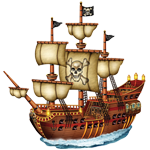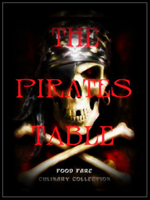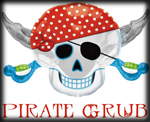![]()
Rank aboard a pirate ship was strictly adhered to. The typical pecking order was as follows:
-
Captain: Commander of the pirate ship.
-
First Mate: Captain's right-hand man who would also assume commanding role if the Captain was killed or could not perform his duties. Captains sometimes chose a quartermaster rather than a First Mate.
-
Quartermaster: Second-in-command; also represented interests of the crew.
-
Boatswain (bos'n): Similar to a chief petty officer; responsible for morale, efficiency and maintenance of the ship’s anchors, cables, hull, lines, rigging and sails.
-
Gunner: Leader of the group manning the ship’s artillery.
-
Powder Monkey: Member of the gun (artillery) crew.
-
Carpenter: Responsible for repairing damage to hatches, hull, masts, seams and yards.
-
Surgeons: Doctors, who were often kidnapped from other ships, were expected to deal with colds, fevers, medicines, sexual diseases and battle wounds which frequently required amputations.
-
Cooks: Quite often, cooks were disabled pirates allowed to remain aboard ship if they could prepare and cook edible food for the crew.
-
Cooper (barrel-maker): The copper built containers to keep gunpowder dry, food free of pests, and to prevent water and spirits from leaking into the bilge. Barrels were made with steel hoops and strong wood.
-
Musicians: Drummers, bagpipers, trumpeters, fiddlers and accordion players provided dinner music or entertainment during uneventful days at sea. They would also play prior to and during a battle to inspire the crew.
Some of the most famous pirate ships and their captains include:
-
Adventure (Edward "Blackbeard" Teach)
-
Bachelor's Delight (William Dampier)
-
 Cassandra
(John Taylor)
Cassandra
(John Taylor) -
Charles (John Quelch)
-
Delight (Francis Spriggs)
-
Desire (Thomas Cavendish)
-
Fancy (Henry Every)
-
Fortune (Bartholomew Roberts)
-
Golden Hind (Sir Francis Drake)
-
Good Fortune (Bartholomew Roberts)
-
Happy Delivery (George Lowther)
-
Liberty (Thomas Tew)
-
Little Ranger (Bartholomew Roberts)
-
Loyal Fortune (Bartholomew Roberts)
-
Mary Anne (Samuel Bellamy)
-
Neptune (Samuel Burgess)
-
New York Revenge (William Kidd)
-
Pearl (Edward England)
-
Revenge (Stede Bonnet)
-
Rising Sun (William Moody)
-
Rover (Bartholomew Roberts)
-
Royal Fortune (Bartholomew Roberts)
-
Royal James (Edward England)
-
Queen Anne's Revenge (Edward "Blackbeard" Teach)
-
Sea King (Bartholomew Roberts)
-
Speaker (John Bowen)
-
Speedy Return (John Bowen)
-
Tiger (Sir Richard Grenville)
-
Victory (Oliver LaBouche)
-
William (John Rackham)
-
Whydah (Samuel Bellamy)
Common ship-types sailed by pirates:
-
Bark (Baroque): Small ship with three masts; said to be a favorite of Caribbean pirates.
-
Brigantine: Ship with two masts; square-rigged forward. Famous brigantines include Roberts' Good Fortune and Sea King, and John Quelch's Charles.
-
Caravel: Small, square-mast ship originally intended for trading.
-
Carrack: Large, three to four-mast sailing ship.
-
Chinese Junk: Chinese sailing vessel with flattened sails, originally built using bamboo.
-
Dhow: Lateen-rigged single mast ship, commonly used in the Middle East.
-
Frigate: Three-mast ship with raised forecastle and quarterdeck. Very few pirates commanded a frigate as they were often used for pirate-hunting instead.
-
Fuste (Fusta): Small ship with sails and oars; mostly used by Barbary Corsairs.
-
Galleon: Large, three-mast sailing ship with multiple decks; mainly used to transport cargo.
-
Galliot (Galiot): Long, sleek and oar-driven with a flush deck; said to be favored by Barbary and Corsair pirates.
-
Galley: Long, low ship propelled by rowers with a flush deck. Famous galleys include Captain Kidd's Adventure Galley.
-
Indiaman: Large merchant ship; square-rigged with three masts.
-
Longboat: Long rowboats carried aboard ship to provide transport to and from land.
-
Schooner: Vessel with two or more masts, and fore-and-aft sails.
-
Shebec: Large, fast ship with overhanging bow and stern, and three lateen-rigged masts. Said to be a favorite of Barbary pirates.
-
Sloop: Sail boat with a single mast. Famous sloops include Blackbeard's Adventure, Bellamy's Mary Anne, Bonnet's Revenge and Rackham's William.
-
Tartan: Fast, narrow ship with one mast, lateen mainsail and small foresail; mainly used by Barbary and Corsair pirates in the Mediterranean.
Some of the common tools and weapons used by pirates.
-
Belaying Pins: Used to secure lines of rigging on a ship; made from wood or metal, the pins were also used as improvised weapons.
-
Blunderbusses: Close-range weapons similar to Musketoons. Usually loaded with large pistol balls, nails or glass.
-
Boarding Axes: Various boarding axes were used in the course of ship work, but were also utilized as lethal weapons.
-
Boarding Pikes: Long spears with wooden handles and metal points.
-
Bucklers: Small shields used in hand-to-hand combat.
-
 Caltrops
(aka crow's foot, pictured at right): Two nails shaped into
a tetrahedron; thrown at the feet to impede or stop advancing enemy.
Caltrops
(aka crow's foot, pictured at right): Two nails shaped into
a tetrahedron; thrown at the feet to impede or stop advancing enemy. -
Cannons: Used aboard ship to fend off encroaching enemies. During the height of piracy, different types of cannons were used aboard ships. The most common shots were bar & chain, bundle, canister, grape, hot iron, round shots and sangrenel (which was a cloth bag filled with jagged pieces of iron). Small cannons were also used, known as Swivel guns or Patarero.
-
Crossbows: Little-used after being replaced by firearms, crossbows were still utilized on occasion to strike people on the decks of other ships.
-
Cutlasses: The weapon of choice for sailors and pirates alike. Short and broad, cutlasses had straight or slightly curved blades with cupped hilts and basket-shaped guards.
-
Daggers: Knives with sharp points which were used as both stabbing and thrusting weapons. They were known in some cultures to signify courage and daring in combat. During the Renaissance period, daggers were often part of daily dress. They were also the only weapons allowed to be carried by commoners. While daggers were plain and functional for the most part, those used by the upper class could be exquisitely designed with detailed carvings, jeweled handles and held in colorful scabbards.
-
Dirks: Long daggers known to be used in hand-to-hand combat, especially during the Age of Sail (16th to 19th centuries). Naval dirks were long thrusting weapons once worn mainly by midshipmen. They later became ceremonial pieces, symbolizing badges of specific rank.
-
Flintlocks: The flintlock mechanism was used in muskets, pistols and rifles between the 17th and 19th centuries. According to historians, the firearm-igniting mechanism was invented by French artist and inventor Marin le Bourgeoys in 1610.
-
Grappling Hooks: Multiple-fluked hooks attached to rope which could be dropped, fastened, projected, sunk or thrown by hand. The most common use aboard ship was to secure rigging for boarding.
-
Grenadoes (grenades): Hollow iron balls filled with explosive powder and capped with fuses. Most had a slight dimple on the bottom to prevent rolling on deck, with a hole on top for the fuse. The fuse usually consisted of a tapered length of wood inserted into the hole.
-
Marlinspikes: Typically used for rope work (splicing, untying knots), but the metal cone tip could also be bandied as a weapon.
-
Matchlock: Known to be the first invented lock to support the firing of a hand-held firearm.
-
Musket: Muzzle-loaded early model of the rifle with a smooth-bore barrel; typically used by pirates for long-range sniper shots.
-
Musketoons: Short variety of a musket rifle; close-range weapon easier to handle because of its small size (eight to ten pounds).
-
Rapiers: Slender swords with sharp points and protected hilts; mainly used as a thrusting weapon.
-
Scimitars: Curved backsword often depicted with visual stereotypes of pirates. In truth, the scimitar (saif) was originally developed in the Middle East. Also known as kilij, nimcha, pulwar, shamshir and talwar.
-
Snaphance: Predecessor of the flintlock, snaphances implemented the firing mechanisms of guns. Term derived from the Dutch word Schnapphahn (snapping lever).
-
Wheel-Locks: Reportedly invented in 1517 by Johann Kiefuss of Nuremberg, wheel-locks were friction-wheeled mechanisms which caused sparks for arms firing. They were eventually replaced by snaphances and flintlocks.


